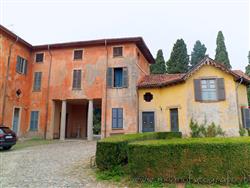|
Sirtori (Lecco, Italy): Villa Besana
|
|
|
Show an other place around Milan worth a visit: |
 HISTORY HISTORY
Villa Besana is the remaining part of the old castle of the Sirtori family, an ancient noble family descended from the gens sertoria, named by Francesco Sforza Duke of Milan in 1449, Family Sirtori. The building of the villa stands on the ruins of the ancient castle, its construction dates back to the 1500s while the park was built later, presumably from the first half of the nineteenth century, as shown in the drawing found in the family archive illustrating a draft of the project for the formation of a water basin, the pond still existing in the garden, dated 3 December 1845 and signed by the Milan engineer Medici. The villa came to the Besana family in a succession: in 1806 Costanza Besana married Febo Prevosti and their daughter Teresa married in 1845 Gaspare Sirtori, and dying in 1890 appointed heir Giovanni Besana.
The complex is located in the center of Sirtori, not far from the square of the parish church and the Town Hall, on the provincial road that connects Sirtori to Viganò, and is composed of the main building destined to be a private residence, the porter's lodge, rural buildings, stables, garages and converted barns and of the oratory of the Madonna Assunta, located outside the gated complex, on the opposite side of Giovanni Besana street, in front of the entrance of the villa.
THE VILLA
The building has facades with austere and elegant architectural lines; tripartite horizontally by thick cornices and embellished with elegant small balconies with wrought iron railings. Rectangular windows with large frames mark the prospects, presumably the result of an eighteenth-century renovation. The interior rooms (not photographed because they are only partially accessible and in any case inhabited and lived) have beautiful eighteenth-century marble fireplaces, wooden ceilings with sober decoration and beautiful decorated wooden doors.
The villa has undergone frequent changes over time. The last important structural changes date back to the twenties and thirties of the twentieth century, when part of the buildings towards the main entrance on Giovanni Besana street were demolished, with a consequent extension of the rustic courtyard at the back of the main building.
Beyond the boundary wall stands the seventeenth-century oratory, with an architrave portal surmounted by a beautiful window completed by a curved gable.
Note that the bell tower is located on the roof of the villa and consists of a double bell gable with two bells.
THE PARK
However, what most characterizes the villa is its park, which has the peculiarity of occupaying, for an important part, the sides of the hill on which the villa is located. It can even be said that it was modeled precisely so as to adapt to the complex orography of the area occupied by it.
However, the park is fairly recent: it did not exist before the 30s of the nineteenth century, when the acquisition of all the land belonging to the current property was completed; it was most probably initiated by Gaspare Sirtori, who built the lake in 1845, and in 1896 it presented an important and certainly not random vegetation that had reached maturity.
One of the park's many peculiarities is the fact that the access road leading to the villa does not cross it linearly, but on the contrary following a winding path, so as to increase the perceived size of the park.
In a sense, the park of Villa Besana is more like a botanical park, due to its species richness and the presence of many monumental trees, than as a simple leisure park structured according to purely aesthetic criteria. A part, in fact, could even appear completely spontaneous, also in virtue of the presence of meadows in which spontaneous herbs are allowed to grow freely and of a large pond. Finally there is also a part used for the cultivation of aromatic herbs.
In the seventies of the twentieth century the swimming pool was built, unfortunately on the perspective axis of the main telescope towards Monza and Milan.
Also the classical-looking statues representing allegories of the four seasons in front of the inner façade were only put in place around the middle of the last century.
Categories: Places of historical value of landscape value
Via Giovanni Besana 2 - 23896 Sirtori (Lc) |
Further pictures of Villa Besana in the section Photography |